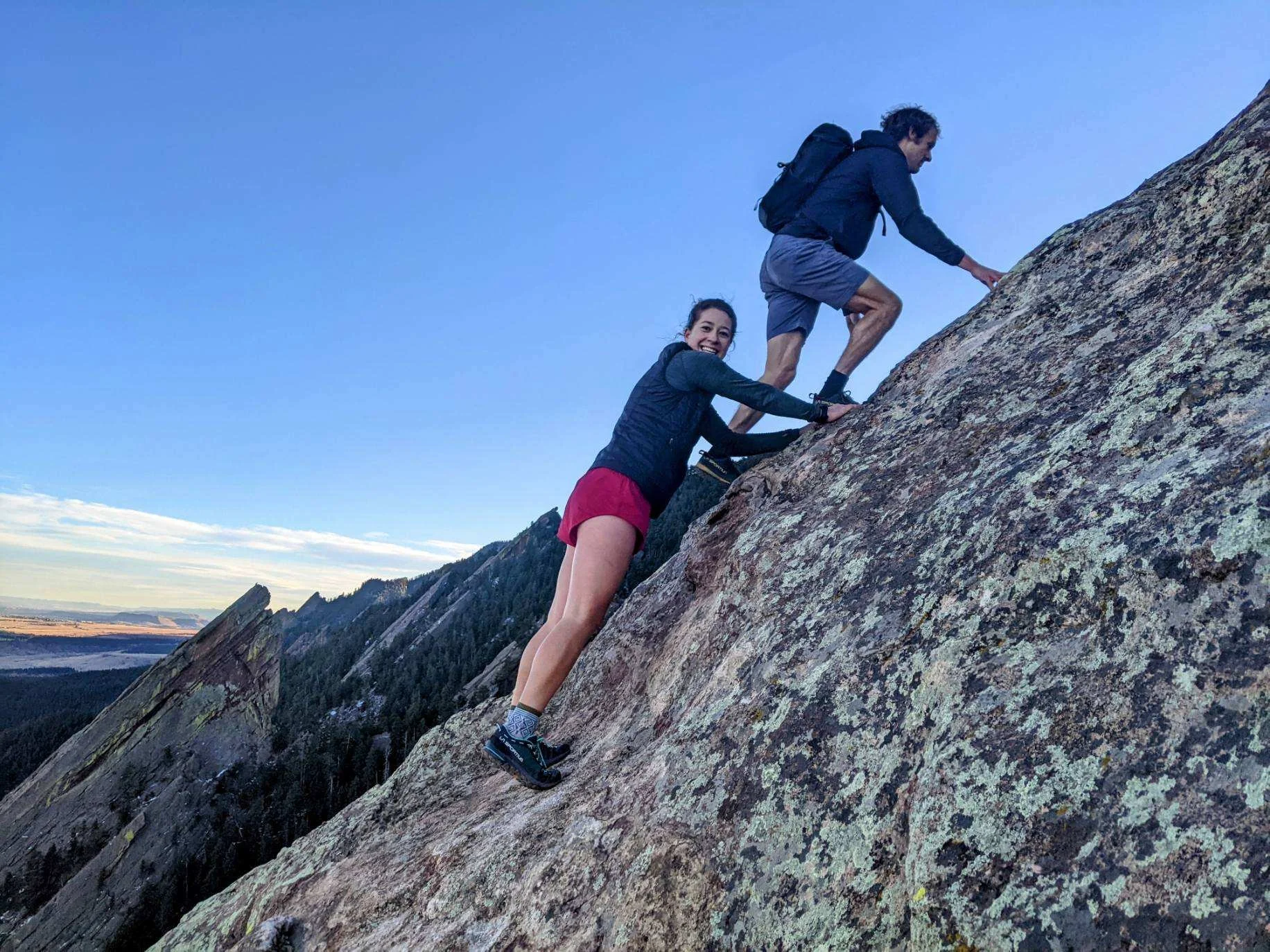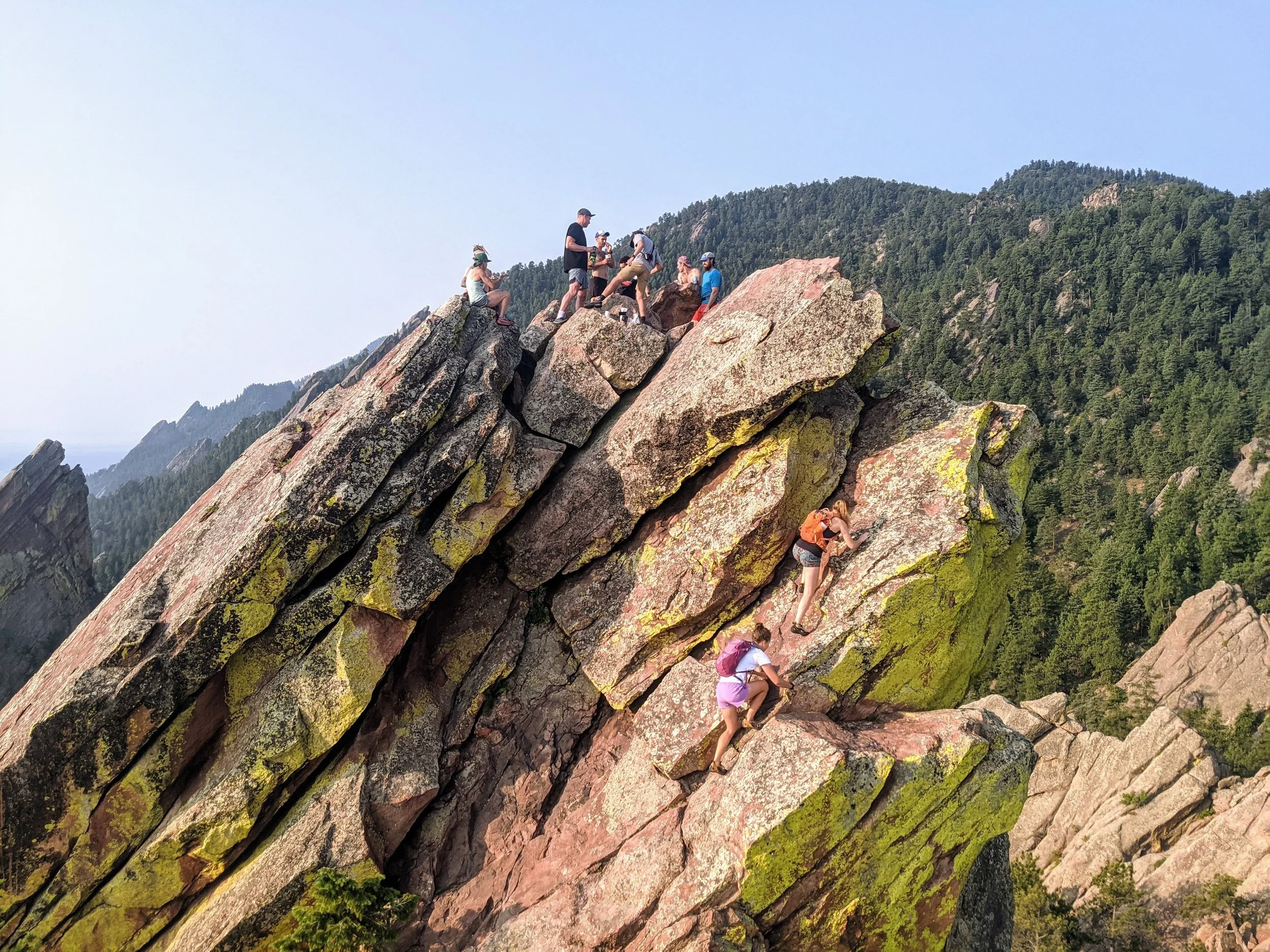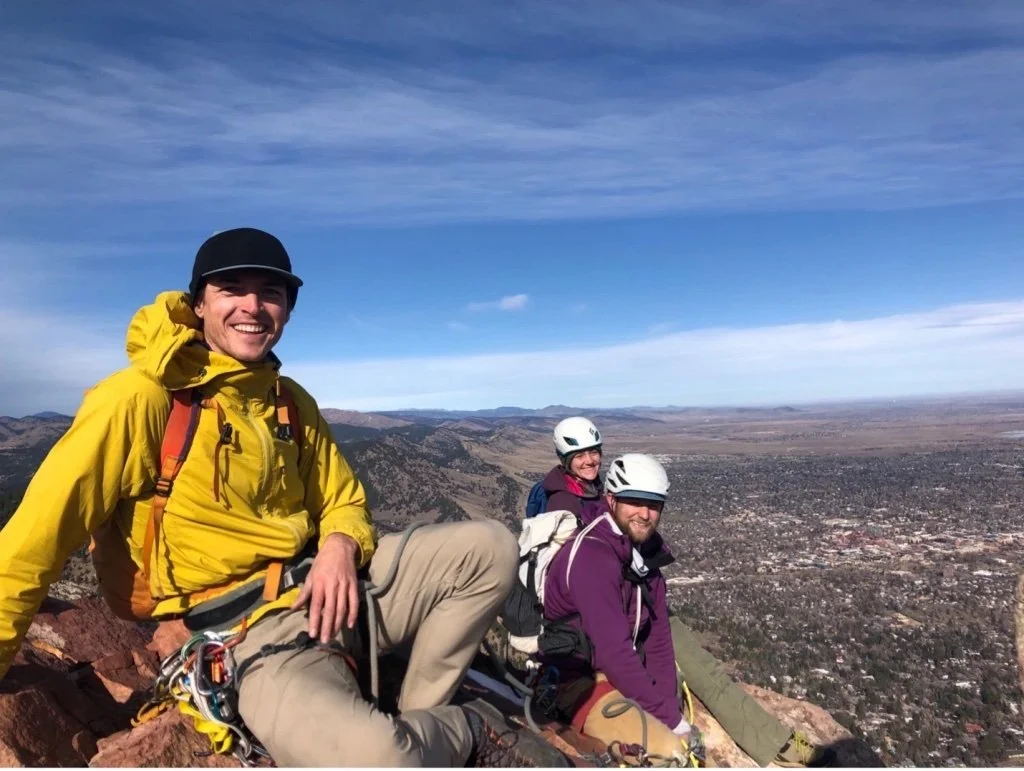Finding Friendship an Adventure in Boulder’s Flatirons
On Thursday, Dec. 30 2021 at 10:37a.m. Bill Wright received a text from his longtime climbing partner and friend Stefan Griebel.
Trapped by the wind on the down climb. Gonna have to wait out. Temps ok.
Griebel had been “gridding” the First Flatiron. “Gridding” is a meticulous process. For Griebel it involves climbing “the First” all 365 days of the calendar year plus Leap Day. If he climbed the First on Dec. 30, he could cross that day off his grid chart never having to climb it on that day again. But if he missed that day, he would have to wait an entire year to get another opportunity to complete the climb.
At 10:50a.m. Wright responded.
Yikes! Let me know if you need a rescue. Crazy wind out there. I could come up there with a rope and a couple of harnesses.
Wright knew the situation was dire when Griebel accepted his offer. He gathered his gear in a frenzy and drove back to the Flatirons where he’d just returned from his morning summit of Green Mountain. The winds were ripping as he headed up the Chautauqua trailhead.
Wright was intimately familiar with the Flatirons. Inspired by a National Geographic article about climbing and Boulder’s captivating terrain, he dedicated all of his free time to the activity. His obsessive behavior was reflected in his climbing accomplishments and setbacks catalogued in his blog. After a climbing accident that resulted in a broken back, Wright dedicated his recovery period to scrambling the top 10 Flatirons using Gerry Roach’s guide book, “Flatiron Classics.”
Scrambling is a less technical style of climbing that involves using one’s hands and feet to go up steep rocky faces without any gear. Although some would argue that this style of climbing is free soloing, Wright thinks otherwise. “I view soloing as something where if your arms got tired, you’d be in trouble. Almost always, you can just stand there.”
Alyse Little completing the final move of the down climb on the back side of the First Flatiron. Image taken by Diana Boyer.
Karl Mayer and Diana Boyer head up the Direct East Face of the First Flatiron. Image taken by Eva Krchova.
The rock faces are at a gentle enough incline that the trickiest moves are usually graded at 5.6 or lower on the Yosemite Decimal System. Wright describes the Flatirons saying, “These rocks, as far as I know, are unique in the world. They are so big, so solid, so gently angled that the average athlete, with practice, can be confident and safe scrambling them.”
Scrambling is not without risk, however. Not due to the rock face, but because of the unpredictable variables of individual ability and weather. Each person has their own risk tolerance and experience when it comes to climbing. Emotions can quickly change once you’re 100 feet above the ground.
Becca Droz a climbing guide for Denver Mountain Guides stresses the importance of checking in with yourself before climbing. She says, “One of the bravest things you can do is bail.” She has led many parties up the face of the First Flatiron, but with rope and rock protection. She enjoys sharing the experience with others and helping them achieve their goals. When a rope is involved, it allows the clients to focus on the climbing without the fear of falling.
On the particular day Griebel chose to scramble, the winds were blowing at a sustained 100 miles per hour. Wright took Atalanta, the fastest route to the top of the First. He waited for a lull in the wind, crested the summit, and booked it to a sheltered hole where he could stuff the rope and prepare his rappel. Griebel was waiting for him 15 feet below, huddled in a sloping slot. He was freezing having lost feeling in his hands and feet.
Griebel was one of the best climbers Wright knew and the allure of a “grid” day ultimately led Griebel to a dangerous decision. As Wright got the rope through the rappel rings, he was careful not to let go of it. There was risk that the ends of the rope could blow over the front of the rock and get stuck. He lowered himself down, the wind smacking him into the wall and settled next to his shivering friend.
Kyle Richardson, a professional runner, has been known to seek fast times in the Flatirons. A fellow competitor and champion in Bill Wright’s Tour de Flatirons, he has dedicated the last eight years trying to master scrambling up the foothills efficiently. For Richardson, scrambling is like a recital. First, you practice the moves, then rehearse the entire sequence, and bring everything together in the performance. “I feel alive and in tune with what’s going on. Definitely tapping into a bit of a flow state when you’re really pushing it. You have to be on point if you’re deciding to go that fast.”
Wright’s tour has brought the scrambling community together. It happens every year in September over the span of five weeks. Each week, there is a new stage that involves linking up different Flatirons and competing for time. Wright says, “It’s a great group of people who love positive competition. They all want to go super hard. Tremendous pain can be fun.”
While scrambling can be competitive most individuals enjoy the social aspect of it. Wright describes it as a Via Ferrata without the cable. A distinctly European activity, a Via Ferrata is a protected climbing route comprised of steel cables, ladders, and other fixed anchors that assist even the inexperienced climber to ascend a rock face. Its ladder-like construction allows for people to be climbing in front of and behind you. When scrambling, Wright says, “You’re all together and you’re chatting up the rock.”
A group of friends meet atop of the summit of the First Flatiron for coffee and donuts. Image taken by Eva Krchova.
For graduate student Margaret Morgan, climbing up the First Flatiron was a fun way of getting out with her friends and escaping the stressors of academia. Having never climbed in the Flatirons before, Morgan couldn’t believe the accessibility. She found the outing to be unique. “We’re climbing pretty much next to each other. I never climb with three people, let alone climb next to my friend.”
Jonas Hill, Margaret Morgan, and Evan Davis sitting atop the ridge of the First Flatiron. Image taken by Diana Boyer.
With adventure so close, it’s important to not take the Flatirons for granted. The rocks are there for you, only if you take the time to get to know them. For mountain guide Droz, they represent something more than big rock faces. “I feel the Flatirons is like the sanctuary of returning home. Returning home back to myself and returning home to what I love about Boulder.”
After struggling to get their harnesses on, Griebel lowered himself to the ground with Wright on his tails. They could barely hear each other over the gale force winds, but little needed to be said. Griebel hugged his friend and Wright sent him down the trail urging him to seek warmth. Coincidentally, the same winds that trapped Griebel created one of the worst fires in the history of Colorado, destroying 991 homes.
The Flatirons are a beacon for visitors and locals alike. They will reward you for thoughtfulness. Wright recommends, “You should go out and do these things with a rope, rock shoes, and a partner and decide for yourself. Don’t just go scrambling in running shoes without having ever done it.” It can be deceptive because the experts make it look approachable and easy. Wright and Greibel have climbed the different flatirons hundreds of times. Richardson has each move memorized on the face of the First. Whether climbing with a rope, scrambling with friends, or hiking through the Flatirons there is an adventure for everyone.
Walker Mackey starting the down climb on the backside of the First Flatiron, the Third Flatiron shining in the sun behind him. Image taken by Diana Boyer
Feature image: Diana Boyer scrambling up the face of the First Flatiron. Image taken by James Lucas.




